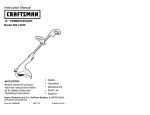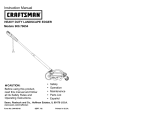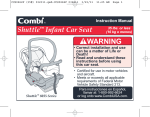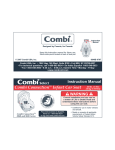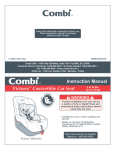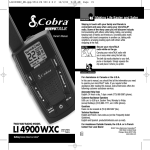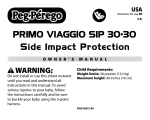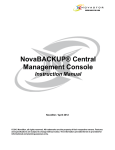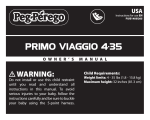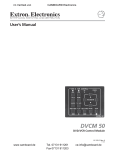Download Combi Centre DX 8074 Car Seat User Manual
Transcript
INSTRUCTION MANUAL 5 to 22 lbs. (2.3 to 10 kg) Centre Infant Car Seat TM rC H h or Combi USA, Inc. a n d T eth er WARNING Correct installation and use can be a matter of life or death! Read and understand these instructions before using this car seat. Store these instructions in the pocket provided at the back of the car seat. Certified for use in motor vehicles and aircraft. Meets or exceeds all applicable requirements of Federal Motor Vehicle Safety Standard 213. CEICS10/05 Keep this instruction manual for future use. Store in the pocket at the back of the car seat fo Lo wer Anc il d r e n L AT C H Centre ST 8065 Series Centre DX 8074 Series Centre EX 8086 Series Para instrucciones en Espanol, llamar al: 1-800-992-6624 Section 1 - Contents 1 Section 1 - Contents 2 Section 1. Contents....................................................................................1 Section 11. Vehicle Belt Systems.......................................................39 - 44 Section 2. Warnings.............................................................................3 & 4 Section 12. Accessories...................................................................45 & 46 Section 3. Proper Use ................................................................................5 Section 13. Stroller, Travel System and Airplane use.........................47 & 48 Section 4. Assistance..................................................................................6 Section 14. Other Uses......................................................................49 & 50 Section 5. Car Seat and Base Parts....................................................7 - 10 Section 15. Care & Cleaning.. ...................................................................51 Section 6. Securing Infant in Car Seat...............................................11 - 18 Section 16. Additional Information..............................................................52 Section 7. Installing the Car Seat - General Information.................. 19 - 24 Section 17. Registration Information...................................................66 - 77 Section 8. Installing the Car Seat Base with LATCH ....................... 25 - 28 Section 18. Replacement Parts...........................................................66 - 77 Section 9. Installing the Car Seat Base with Vehicle Belts............... 29 - 34 Section 10. Installing the Car Seat without the Base ...................... 35 - 38 WARNING: No infant car seat can guarantee protection from injury in every possible situation. However proper use of this infant car seat helps reduce the risk of serious injury or death. Section 2 - Warnings WARNING 3 DEATH or SERIOUS INJURY can occur Failure to follow the information in these instructions, and on the car seat labels, can result in injury or death to a child due to the child striking the vehicle's interior during a sudden stop or crash. Warnings concerning use with an infant: Use only with children who weigh between 5 and 22 pounds (2.3 and 10 kg) and whose height is 29 inches or less (74 cm). Do not use the car seat if the top of the infant's head is above the top of the car seat backrest. Snugly adjust car seat harness around infant. Infant MUST be secured by harness system at all times, both when car seat is used in vehicle, and when car seat is used outside of vehicle. Section 2 - Warnings 4 If using the car seat base, secure with the LATCH system if anchorage points are available in the vehicle, otherwise use one of the vehicle seat belt systems to secure the base. If using the car seat without the base, secure with one of the vehicle belts. LATCH system straps or vehicle belts MUST stay tightly adjusted around the car seat at all times. Secure the base and car seat, or car seat only, to the vehicle even when not occupied. Unsecured items may injure other occupants in a crash. Warnings concerning the car seat: DO NOT allow any re-use of this car seat after a crash unless crash and car seat meet ALL condiutions from NHTSA's information on "Reuse after a crash". For information on re-use after a crash, check the NHTSA website at: www.nhtsa.gov/people/injury/childps/ChildRestraints/ReUse/ The car seat MUST be installed REAR facing in the vehicle. Serious injury or death can result if the infant faces forward. DO NOT use the car seat if it is damaged, has missing parts, or missing instructions. Section 3 - Proper Use Check List WARNING DEATH or SERIOUS INJURY can occur WARNING: AIRBAGS Do not use the car seat in a vehicle front seating location with an air bag. Child's head and back may be seriously injured when an inflating air bag hits back of car seat. Owners of vehicles with front passenger side air bags should refer to their vehicle ownerís manual for child restraint installation instructions. . .. .. .. 5 Proper Use is required. Read and understand the instructions and car seat labels. Use this infant car seat REAR-facing only. Snugly adjust harness straps around infant. Securely install the car seat with LATCH system, or vehicle belt. Secure the car seat in back seat whenever possible. Never leave child unattended. Do not allow anyone (babysitters, relatives etc) to use the car seat without first reading and understanding all the car seat instructions and labels. Section 4 - Assistance 6 NEED HELP? Contact one of the following sources: 1. your vehicle dealer to locate a child safety seat inspection station in your area. 2. call 1-866-SEAT CHECK ( 1-866-732-8243). 3. visit www.nhtsa.dot.gov and select "Child Seat Inspections". 4. visit www.seatcheck.org. 5. contact a certified child passenger safety technician in your area. To locate a certified "Child Passenger Safety" technician in your area visit www.nhtsa.dot.gov and select "Child Passenger Safety" and then select "Technician Contact Locator". Section 5 - Car Seat Parts Carry Handle 7 Section 5 - Car Seat Parts Adjustable Headrest (not all models) Instruction Storage Pocket Harness Buckle and Tongues Optional Rebound Bar (not all models) Shoulder Strap Slots Canopy Attachment Points Chest Clip Crotch Pad Handle Release Button Harness Adjuster Button Vehicle Lap Belt Slots Harness Adjuster Strap Stroller Latch 8 Release Handle for Stroller and Base Locking Clip Storage Position Headrest Adjuster Knob Harness Connector Plate Base Latch Section 5 - Base Parts 9 Recline Foot Adjustment Section 5 - Base Parts Vehicle Belt Routing Tabs Recline Foot retaining catch (behind flap) LATCH strap (stored in pocket in Recline Foot). Vehicle Belt Locking Clip Car Seat Latching Points Level Indicator Adjustable Recline Foot LATCH Strap Connector 10 LATCH strap adjuster LATCH Strap Connector Vehicle Belt Path Section 6 - Securing Infant in Car Seat 11 Section 6 - Securing Infant in Car Seat 12 OVERVIEW WARNING DEATH or SERIOUS INJURY can occur When the infant is in the car seat, ALWAYS secure with the harness and adjust the harness to a snug ( not loose) fit. Child must be dressed in clothing with arms and legs that will not interfere with buckling, snugly adjusting or positioning harness. DO NOT use accessories other than those provided by Combi USA Inc. Use of accessories from other manufacturers may alter the performance of the car seat. Never leave infant unattended, even when sleeping. CAUTION: After reading this page, read the following detailed instructions carefully Shoulder Straps close to top of infant's shoulders Chest Clip at correct height and fastened Shoulder Straps snug fit on infant Infant's body in full contact with car seat Straps not twisted Suffocation Hazard: Infant Car Seat can roll over on soft surfaces and suffocate child. NEVER place infant car seats on beds, sofas and other soft surfaces. Harness Buckle securely fastened Strangulation Hazard: Child can strangle in loose harness straps. NEVER leave child in car seat with straps that are loose or not connected. Harness pulled up to a secure and firm fit Fall Hazard: Infant's movement may slide car seat. NEVER place car seat near edge of table, countertop or other elevated surface. If infant's head is above top of car seat, infant is too big for this car seat. Infant dressed in clothes that allow the harness to pull firmly on child's body Use only with children who weigh between 5 and 22 pounds (2.3 and 10 kg) and whose height is 29 inches (74 cm) or less. Section 6 - Securing Infant in Car Seat PULL PRESS 13 Loosen harness by pressing Harness Adjuster Button and pulling the shoulder straps outwards. To open harness press red button on buckle NOTE: On some models the Harness Adjuster Button is under the cover, or under a flap. Section 6 - Securing Infant in Car Seat 14 CORRECT POSITIONING OF THE SHOULDER STRAPS HEIGHT IS IMPORTANT. Non-Adjustable Headrest Models The shoulder straps must pass through slots in the car seat backrest that are closest to the top of the infant's shoulders. Place infant in car seat with back and rump contacting seating surfaces. Adjustable Headrest Models Note where the top of the infant's shoulders are located relative to shoulder strap slots. Adjust the height of the Headrest until you get a position that is closest to the top of the infant's shoulders. Section 6 - Securing Infant in Car Seat 15 Section 6 - Securing Infant in Car Seat Non-Adjustable Headrest Models 16 Place harness straps over infants shoulders and thighs, and secure the Harness Buckle. If the height of the shoulder straps needs adjusting, turn the car seat over and detach the straps from the steel connector plate. Reposition the straps as required and reattach the straps. The harness must be a snug (not loose) fit on the infant. A snug strap should not allow any slack. It lies in a relatively straight line without sagging. It does not press the infant's body into an unnatural position. To increase the tension of the harness, pull the harness adjuster strap IMPORTANT: Check that the shoulder straps are securely attached to the connector plate. Straps must not be twisted! "CLICK" IMPORTANT: You should hear a "click" as the buckle tongues engage. Section 6 - Securing Infant in Car Seat Press to release 17 The Chect Clip increases the safety of the harness by holding the shoulder straps together. Position the Harness Tie at arm pit level Always use the Chest Clip when the Infant is secured by the harness. For a small infant a rolled towel can be used on each side for support. Towels must not prevent the harness from being adjusted to a secure fit on the infant. DO NOT place towel or other items behind the infant or between the infant and the harness. Section 6 - Securing Infant in Car Seat 18 INFANTS WITH SPECIAL NEEDS A preterm infant or a low birth weight infant may be at special risk traveling reclined in a vehicle or aircraft. According to the American Academy of Pediatrics, these infants may be at increased risk of suffering breathing or other difficulties if improperly reclined or positioned in a car seat. Have your physician or hospital staff evaluate your infant in this car seat before you and your infant leave the hospital. If your infant is not able to travel in a reclined position, DO NOT use this car seat. Use a car bed for your infant. Section 7 -Installing the Car Seat WHERE IS THE SAFEST PLACE TO INSTALL THIS CAR SEAT? Lap/Shoulder Belt DO NOT place the car seat in front of an airbag 19 Section 7 - Installing the Car Seat If your car has a lap only or lap shoulder seat belt in the CENTRE of the back seat, install the car seat in that position. The safest place in the car for your car seat is in the back seat. Otherwise use the outside position closest to the side of the road. 20 Lap/Shoulder Belt Lap only Belt Lap/Shoulder Belt Buckle Tongue Refer to Vehicle's Owners Manual for installation information Section 7 - Installing the Car Seat WARNING ! 21 DEATH or SERIOUS INJURY can occur Section 7 - Installing the Car Seat 22 DO NOT use car seat on vehicle seats that face the side or the rear of the vehicle. See page 5 for important information about use of this car seat in a vehicle with an airbag. Car seat must be reclined as shown in these instructions, and on the labels : - too reclined can result in injury or ejection, - too upright can result in breathing difficulties. Never put a car seat in a front vehicle seat unless recommended by the vehicle owner's manual. The National Highway Traffic Safety Administration (NHTSA) alert that according to accident statistics, children up to the age of 12 are safer when properly restrained in a rear seating position, rather than a front seating position. The carry handle must be up when the car seat is used in a vehicle. Refer to the vehicle owners manual for car seat installation instructions. After installing car seat into base, lift car seat to ensure it is securely locked into the base. DO NOT use car seat in base if it is not securely locked into place. To rotate the carry handle, press in both release buttons on the sides of the handle at the same time, hold them in, and rotate. Section 7 - Installing the Car Seat 23 Section 7 - Installing the Car Seat Base - General TWO DIFFERENT METHODS OF INSTALLING THE CAR SEAT IN THE VEHICLE. LATCH symbol Lap/Shoulder Belt LATCH. This is a new system (since 2003) that provides anchor points specifically intended for car seats. Check your vehicles Owners Manual to see if your vehicle is fitted with LATCH. The mounting points may also be identified in your vehicle by the LATCH symbol. VEHICLE BELTS Pull flap forward The car seat may also be installed using a lap/shoulder belt or a lap only belt. Lap only Belt WARNING: Not all vehicle belts are suitable for a car seat installation. See Section 11 for more information on suitable vehicle belts. Adjust recline foot 24 INSTALLATION USING THE BASE. Place the vehicle on a level surface. Decide where in the vehicle the car seat is to be installed. Place the car seat base onto the vehicle seat and adjust the level of the base using the adjustable recline foot. Use the level indicator towards the back of the base as a reference to achieve the correct level. In some vehicles it may be necessary to use a rolled towel or pool noodle under the front of the base to assist in getting the correct level. To move the base foot to a new position, pull the front panel outwards and reposition the base foot as required. WARNING: Read the information on page 21 about having the car seat too upright or too reclined. If it is not possible to install the base at the correct angle, try a different position or do not install in the vehicle. Section 8 - Installing the Car Seat Base with LATCH 25 Section 8 - Installing the Car Seat Base with LATCH The LATCH strap is stored in the base foot. To remove the LATCH strap, swing the base foot open by adjusting it to the maximum downwards position and then pressing the release catch. LATCH strap stored in base foot Remove the LATCH strap from its storage position. WARNING:LATCH connectors must be secured to the vehicle LATCH anchorages only. Pull LATCH strap tight Press down firmly on base 26 If the LATCH strap is too short, rotate the LATCH strap adjuster upwards to loosen the LATCH strap. Route the LATCH strap under the Vehicle Belt Routing Tabs and over the top of the base as shown. Connect the LATCH strap connectors to the vehicle anchorages. Excess vehicle belt can be passed back under the routing lugs and through the built-in Locking Clip. See page 31 for information on using the built-in Locking Clip. Press down on the base and pull the LATCH strap as tight as possible. WARNING: Never attach more than one anchor to a vehicle lower anchorage unless recommended by the vehicle Owners Manual. Section 8 - Installing the Car Seat Base with LATCH 27 Section 8 - Installing the Car Seat Base with LATCH 28 Check that the base is securely held. FITTING THE CAR SEAT INTO THE BASE. If the base moves easily more than 1" (25mm) to either side, try another position, or do not use the car seat in the vehicle. Before putting the car seat into the base make sure there are no objects on or in the base. "CLICK" Connect the car seat to the base. NOTE: listen for a "CLICK" when the car seat is installed into the base, and lift the car seat to ensure the car seat is fully conected to the base. When installing the base, ensure the bottom of the base is in contact with the vehicle seat. NOTE: See additional information on page 33 about putting extra support under the front of the base. To remove the carseat from the base, pull firmly upwards on the release lever at the rear of the car seat, and lift the carseat upwards. WARNING: DO NOT use the car seat if it is not securely connected to the base. Section 9 - Installing the Car Seat Base with Vehicle Belts Pull Belt tight Press down firmly on base 29 LAP ONLY BELT Select the best position in the vehicle and position the base at the correct angle. (See pages 19,20,21 and 24) Section 9 - Installing the Car Seat Base with Vehicle Belts Pull Belt tight Press down firmly on base 30 LAP/SHOULDER BELT Select the best position in the vehicle and position the base at the correct angle. (See pages 19,20,21 and 24) Pass the vehicle Lap belt over the front of the base threading the belt under the routing lugs, and through the built-in Locking Clip. Route the vehicle Lap belt over the front of the base threading the belt under the routing lugs, and through the built-in Locking Clip. Pull the belt tight! Pull the belt tight! Excess vehicle belt can be passed back under the routing lugs and through the builtin Locking Clip. WARNING: Read the information on page 21 about having the car seat too upright or too reclined. If it is not possible to install the base at the correct angle, try a different position or do not install in the vehicle. Shoulder belt Then pass the shoulder belt back under the routing lugs and through the Locking Clip. Maintain the belt tension. WARNING: Not all vehicle belts are suitable for a car seat installation. See Section 11 for more information on suitable vehicle belts. Section 9 - Installing the Car Seat Base with Vehicle Belts Locking Clip 31 Section 9 - Installing the Car Seat Base with Vehicle Belts 32 BUILT-IN LOCKING CLIP Check that the base is securely held. Always pass the belt holding the Base through the Locking Clip even when only one belt is used, e.g. a LATCH or Lap only belt. If the base moves easily more than 1" (25mm) to either side, try another position, or do not use the car seat in the vehicle. Using the Locking Clip will improve the overall performance of the car seat in a crash. LATCH or Lap Belt Locking Clip Lap Belt Shoulder Belt When the Base is secured with a Lap/Shoulder Belt both the Lap and Shoulder belts need to pass through the Locking Clip. When installing the base, ensure the bottom of the base is in contact with the vehicle seat. Section 9 - Installing the Car Seat Base with Vehicle Belts 33 Section 9 - Installing the Car Seat Base with Vehicle Belts FITTING THE CAR SEAT INTO THE BASE. Some vehicle seats do not provide enough support to hold the base up at the required angle. If extra support iis required a tightly rolled towel or a firm foam roll (pool noodle) can be used. 34 Before putting the car seat into the base make sure there are no objects on or in the base. "CLICK" Connect the car seat to the base. NOTE: listen for a "CLICK" when the car seat is installed into the base, and lift the car seat to ensure the car seat is fully conected to the base. Any extra support used to hold the car seat up must not interfere with the Vehicle Belts. To remove the carseat from the base, pull firmly upwards on the release lever at the rear of the car seat, and lift the carseat upwards. WARNING: DO NOT use the car seat if it is not securely connected to the base. Section 10 - Installing the Car Seat without the Base 35 Section 10 - Installing the Car Seat without the Base ADDITIONAL SUPPORT FOR THE CAR SEAT Decide where in the vehicle to install the car seat. Check that the carseat will sit firmly in that position. Some vehicle seats do not provide enough support to hold the car seat up at the required angle. To position the car seat at the correct angle adjust it until the line on the side labels is level. This line must be horizontal If it is not possible to get the carseat sitting firmly and level move it to another position in the vehicle or do not install in that vehicle. Rolled Towel or similar This line must be horizontal If extra support is required a tightly rolled towel or firm foam roll (pool noodle) can be used. Any extra support used to hold the car seat up must not interfere with the Vehicle Belts. Some models have a rebound bar for additional stability in the vehicle. Carseats having this bar must still be positioned as shown by the line on the label. WARNING: Not all vehicle belts are suitable for a car seat installation. See Section 11 for more information on suitable vehicle belts. 36 Vehicle Belts must run in straight line SECTION 10 - Installing the Car Seat without the Base 37 38 LAP ONLY BELT LOCKING CLIP To install with a Lap only belt pass the belt from one side of the carseat to the other. Fit the belt under the lugs in front of the handle. A Locking Clip is supplied with the car seat and is stored at the back of the carseat. Pull the belt tight! LAP/SHOULDER BELT To install with a Lap/shoulder belt pass the Lap belt from one side of the carseat to the other. Fit the belt under the lugs in front of the handle. Fit a Locking Clip to the Lap and Shoulder belts just above the vehicle belt latch. Pull the belts tight! Locking Clip SECTION 10 - Installing the Car Seat without the Base NOTE: A Locking Clip MUST be used with a Lap/Shoulder belt with a tongue that moves freely along the belt, or with a Lap/shoulder belt where the Lap portion of the belt cannot be tightly secured. To fit the Locking Clip, first fit to the Lap Belt as shown opposite, then fit the Shoulder Belt through the Locking Clip over the top of the Lap belt. Keep the belts tight! WARNING: If the Locking Clip is not used where required, the car seat will not be held securely in place. Remove Locking Clip from the vehicle belt when not in use. DO NOT use the Locking Clip as a vehicle belt shortener. Section 11 Vehicle Belt Systems WARNING 39 DEATH or SERIOUS INJURY can occur Section 11 Vehicle Belt Systems Seat Bight Not all vehicle seat belts can be used with a car seat. The car seat must be held tight at all times by a lap belt (or the lap portion of a lap/shoulder belt) that will not loosen while driving. . . . . . Follow all instruction labels on vehicle seat belt and car seat. If the car seat does not stay tightly secured after following instructions: Belt forward of seat bight Seat Bight Move car seat to another location in the vehicle, or Contact vehicle dealer for assistance, or See page 6 of this manual for other sources of aassistance. BELTS FORWARD OF SEAT BIGHT Vehicle seat belts located forward of the seat bight may not hold the car seat securely. Check vehicle Owners Manual or see vehicle dealer for car seat installation instruction. To provide a secure installation in the vehicle: Read the Owners Manual regarding car seat installation and vehicle seat belt use with a car seat, 40 Buckle forward of seat bight If seating position is approved for use with car seat, install car seat and check for secure installation by pulling car seat front to back. If car seat slides forward or vehicle seat belt does not stay tight, DO NOT use these seat belts. Section 11 Vehicle Belt Systems Flipping latch plate over in some cases improves locking 41 Section 11 Vehicle Belt Systems 42 LAP BELTS - Manually Adjustable LAP BELTS - With Retractor Manually adjustable lap belts normally hold a car seat tightly. However in some cases the locking latch plate on some seat belts may slip and loosen if positioned at a certain angle. If this happens flip the latch plate over and rebuckle. Install car seat and test installation again to see if lap belt stays tight. If not, move car seat to another seating location in the vehicle or do not use in that vehicle. Some lap belts with a retractor will not hold a car seat securely. Follow these steps to determine if you have a retractor system that will hold a car seat securely: 1. Pull belt all the way out. 2. Allow belt to retract about 6 inches (15 cm). 3. Pull out on belt again. If belt is locked and you cannot pull the belt out any further, you have an Automatic Locking Retractor which may be used with a car seat. Remember, when installing a car seat, pull the belt all the way out, buckle belt, then tighten. If the belt pulls out (step 3) the Retractor is an Emergency Locking Retractor which must NOT be used with a car seat. Section 11 Vehicle Belt Systems 43 Section 11 Vehicle Belt Systems Combination Lap/Shoulder Belt with Free Sliding Latch Plate Pull out on latch plate. If belt slides freely through latch plate, the Locking Clip MUST be used . Some combination lap/shoulder belts with free sliding latch plates may be converted into an ìautomatic locking modeî. Always use the Locking Clip with these belt systems. Combination Lap/Shoulder Belt with Locking Latch Plate Vehicle seat belts with locking latch plates normally hold a car seat tightly. However in some cases, the locking latch plate on some seat belts may slip and loosen after being buckled on car seat if positioned at a certain angle. If this happens, flip the latch plate over and re-buckle. Test installation again to see if this works. If not, move car seat to another seating location. 44 PASSIVE RESTRAINTS Lap Belt with Motorized Shoulder Belt DO NOT use with any car seat. Front Door PASSIVE RESTRAINTS Lap or Shoulder belt mounted on Front Door DO NOT use a car seat in any front seating location that has belts mounted to the front doors. Belts will not stay tight when driving. Section 12 Accessories 45 INFANT IINSERT Some models have a canopy with plastic stays that connect to the car seat. Some models have a separate infant insert inside the car seat for greater comfort. When the canopy is used make sure it is always connected securely to the car seat. WARNING: Shoulder straps must pass through slots in insert. Failure to do this might result in the shoulder straps not holding the infant securely. TO CONNECT: REBOUND BAR 1. Feed the canopy stay into the mounting. Some models have a Security Bar that installs to the front of the car seat. Always follow the instructions fully and test that the bar is firmly locked into place once installed. When removing take care not to bend the mounting. 2 46 CANOPY 2. Swing the canopy stay inwards until the stay locks in place. 1 Section 12 Accessories WARNING Do not lift or carry car seat by rebound bar Section 13 Stroller or Travel System and Airplane use 47 STROLLER or TRAVEL SYSTEM (Also see Travel System Instructions for further information) Section 13 Stroller or Travel System and Airplane use To remove the car seat from the stroller, pull firmly upwards on the release lever at the rear of the car seat, and lift the car seat upwards. This car seat will only fit into certain Combi stroller models. To connect the car seat to the stroller hold the carseat above the mounting points on the stroller and carefully push downwards. Listen for the "click" to indicate the car seat is securely engaged, then pull upwards to test for secure engagement. NEVER use the car seat in a stroller if it is not securely engaged. "CLICK" WARNING: Do not use this car seat with other model strollers unless approved by Combi USA Inc. 48 This restraint is Certified for Use in motor vehicles and aircraft. Contact airline about their policy on use of car seats in their aircraft. Use this car seat only on forward facing aircraft seats. Follow the installation instructions for Lap Belt only when used on aircraft. Section 14 Other Uses 49 Section 14 Other Uses 50 ROCKER POSITION FEEDER POSITION When the carry handle is back, the car seat can be used as a rocker. When the carry handle is fully rotated, the car seat can be used as a feeder. WARNING: Adult supervision is required, do not leave unattended. WARNING: Adult supervision is required, do not leave unattended. DO NOT carry a child in the car seat by holding the front edge of the car seat and the handle in the position shown. WARNING: Car seats are intended for the safe transport of infants. To securely restrain the infant, their movement is restricted by the seat and the harness. Infants should not be left in this position for long periods of time. Section 15 Care and Cleaning 51 CLEANING COVER To remove cover first detach shoulder straps by disconnecting the splitter plate at the rear of the seat. Then withdraw the shoulder straps and pull them through the cover. Lift the cover off. Wash according to the instructions on the back of the cover. CAUTION: When replacing the cover always check that the shoulder straps are correctly secured to the splitter plate. See page 15. CLEANING HARNESS Surface wash with mild soap and damp cloth. CLEANING SHELL Wipe with a mild solution of soap and water. Avoid wetting labels. CLEANING BUCKLE Rinse buckle with warm water. DO NOT use household detergents. Never lubricate buckle. Additional Information 52 CERTIFICATION This child restraint comforms to all applicable Federal Motor Vehicle Safety Standards for use in motor vehicles and aircraft. WARM WEATHER Car seat parts can get very hot in the sun or warm weather. To avoid burns always check before putting the child in the car seat. VEHICLE SEAT PROTECTION Protect vehicle seat. Use a thin car seat mat, thin towel or thin blanket under and the behind car seat. CAR SEAT USEFUL LIFE DO NOT use after 7 years from date of manufacture on label. INSTRUCTION MANUAL STORAGE Store Instructions in the pocket at the back of the car seat. Registration Information 53 Child restraints ( car seats) can be recalled for safety reasons. You must register this restraint to be reached in a recall. Fill out the registration card attached to the car seat or send your name, address, and the restraint's model number and manufacturing date to: Combi USA, Inc. 1962 Highway 160 W., Suite #100 Fort Mill, SC 29708 or call: Toll Free: 1-800-992-6624(Se habla EspaÒol) or Fax: 1-803-548-3663 for recall information: Call the US Governments Auto Safety Hotline at 1-888-327-4236 (TTY: 1800-424-9153), or go to http://www.NHTSA.gov Replacement Parts If you need replacements parts call our customer service department: Toll Free: 1-800-992-6624 (Se habla EspaÒol) 54




























